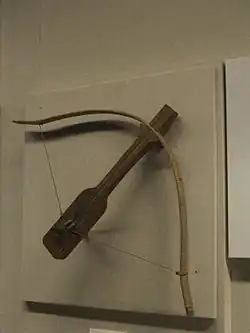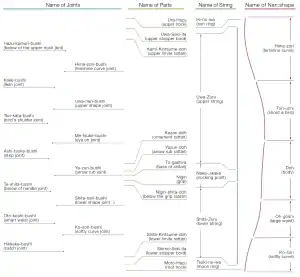大弓
Japanese
Etymology 1

| Kanji in this term | |
|---|---|
| 大 | 弓 |
| だい Grade: 1 |
きゅう Grade: 2 |
| goon | kan’on |
May have been coined in Japan of Middle Chinese-derived components, as a compound of 大 (dai, “large, great”) + 弓 (kyū, “bow”).
Alternatively, may be a reanalysis of older term 大弓 (ōyumi, see below), applying the on'yomi to the characters.
Appears in texts from the 1700s.[1]
Noun
大弓 • (daikyū)
Etymology 2
| Kanji in this term | |
|---|---|
| 大 | 弓 |
| おお Grade: 1 |
ゆみ Grade: 2 |
| kun’yomi | |
| Alternative spelling |
|---|
| 弩 |
/opojumi/ → /oɸojumi/ → */owojumi/ → /oːjumi/
Compound of 大 (ō, “large, great”) + 弓 (yumi, “bow”).[1][2][5]
Listed in the Wamyō Ruijushō of 938 CE.[1][2]
Noun
References
- Shōgaku Tosho (1988) 国語大辞典(新装版) [Unabridged Dictionary of Japanese (Revised Edition)] (in Japanese), Tōkyō: Shogakukan, →ISBN
- Matsumura, Akira, editor (2006), 大辞林 [Daijirin] (in Japanese), Third edition, Tōkyō: Sanseidō, →ISBN
- NHK Broadcasting Culture Research Institute, editor (1998), NHK日本語発音アクセント辞典 [NHK Japanese Pronunciation Accent Dictionary] (in Japanese), Tōkyō: NHK Publishing, →ISBN
- Kindaichi, Kyōsuke et al., editors (1997), 新明解国語辞典 [Shin Meikai Kokugo Jiten] (in Japanese), Fifth edition, Tōkyō: Sanseidō, →ISBN
- Matsumura, Akira (1995) 大辞泉 [Daijisen] (in Japanese), First edition, Tōkyō: Shogakukan, →ISBN
This article is issued from Wiktionary. The text is licensed under Creative Commons - Attribution - Sharealike. Additional terms may apply for the media files.
